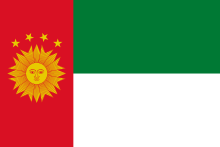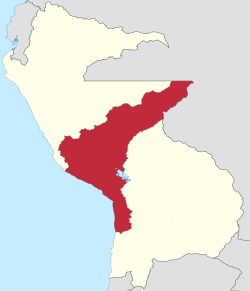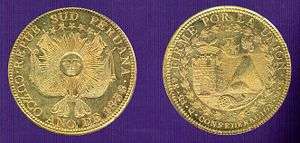Republic of South Peru
The Republic of South Peru was one of the three constituent Republics of the short-lived Peru-Bolivian Confederation of 1836–39.
Republic of South Peru República Sud-Peruana | |||||||||
|---|---|---|---|---|---|---|---|---|---|
| March 17, 1836–August 25, 1839 | |||||||||
 Flag
 Coat of arms
| |||||||||
 South Peru within the Confederation | |||||||||
| Capital | Tacna | ||||||||
| Government | Republic | ||||||||
| President | |||||||||
• 1837-1838 | Ramón Herrera Rodado | ||||||||
• 1838-1839 | Juan Pío de Tristán y Moscoso | ||||||||
| History | |||||||||
• Established | March 17, 1836 | ||||||||
• Disestablished | August 25, 1839 | ||||||||
| |||||||||
| Today part of | |||||||||
South Peru was formed from the division of the Republic of Peru into the Republic of North Peru and the Republic of South Peru. These two Republics were founded in 1836 to be (with the Republic of Bolivia) constituent Republics of the Peru-Bolivian Confederation.
The Confederation came to an end three years later after being defeated by Chile in the War of the Confederation. In August 1839, Agustín Gamarra declared the Confederation dissolved; as a result, South Peru and North Peru reverted to being the single Republic of Peru.
Background
The Peru-Bolivian Confederation was a plan that attempted to reunite the Alto Perú ("Upper Peru", now Bolivia) and Bajo Perú ("Lower Peru", now simply Peru) into a single political and economic entity. Marshal Andrés de Santa Cruz promoted an ambitious project to reunite the two territories on the basis of a confederacy. The integration was based not only on historical, cultural, and ethnic reasons but also on sound economic motives. The union was trying to restore the ancient commercial routes and promote a policy of open markets.
As President of Bolivia, Santa Cruz instigated several failed plots to achieve a political union with Peru, taking advantage of that country's chronic political unrest. His best opportunity came in 1835 when the Peruvian President General Luis Orbegoso requested his assistance to fight the rebel armies of Generals Agustín Gamarra and Felipe Santiago Salaverry. Santa Cruz defeated Peruvian caudillo Gamarra at the Battle of Yanacocha on August 13, 1835, and Salaverry at the Battle of Socabaya on February 7, 1836.
With Bolivian help, Orbegoso quickly regained his leadership throughout the country and had Salaverry summarily executed. In retribution to the support he received from Santa Cruz, he acceded to the formation of the new Peru-Bolivian Confederation. Santa Cruz assumed the Supreme Protectorship of the confederation, and Orbegoso maintained only the presidency of the newly-created Republic of North Peru.
Creation
At the instigation of Santa Cruz, a Congress of the Peruvian southern departments (Arequipa, Ayacucho, Cuzco, and Puno) gathered at Sicuani and declared the establishment of South Peru (March 17, 1836.) Together with North Peru, they recognized Santa Cruz as Supreme Protector with extensive powers that enabled him to create the Peru-Bolivian Confederation on October 28, 1836.
Santa Cruz then summoned to the city of Tacna representatives of both legislatures together with those of the Bolivian Congress assembled at Tapacarí to establish a Constitution for the new State. Under his direction, they signed a pact on May 1, 1837, which named him Supreme Protector for ten years.
Structure of the republic

From 1837 to its dissolution were a Provisional President and a Congress, both with limited powers and under the control of Marshal Andrés de Santa Cruz, who was styled the Supreme Protector.
- First President: General Ramón Herrera Rodado (b. 1799 – d. 1882) (September 17, 1837 – October 12, 1838.)
- Second President: Juan Pío de Tristán y Moscoso (b. 1773 – d. 1859) (October 12, 1838 – February 23, 1839.)
Development and dissolution
Invested with considerable powers, Santa Cruz endeavoured to establish in Peru the same type of authoritarian order he had imposed in Bolivia. He issued a civil code, a penal code, a trade regulation, a customs regulation and procedures for reorganizing tax collection, which allowed an increase in state revenues and reduced expenditures.
However, the Confederation generated resistances among several groups in both countries that resented the dilution of national identities and by neighbouring countries. Many Peruvian politicians opposed to the idea of the Confederation fled to Chile, where they received support and this led to the War of the Confederation Chile declared war on December 28, 1836, and Argentina followed suit on May 9, 1837. The Chilean military expedition against Santa Cruz, led by Admiral Manuel Blanco Encalada, failed and had to submit to the signature of the Treaty of Paucarpata, on November 17, 1837.
The Chilean government then organized a second expedition, which defeated the Supreme Protector at the Battle of Yungay on January 20, 1839 and forced the dissolution of the Confederation. When Agustín Gamarra took office as the new president of Peru on August 25, 1839, he officially declared the dissolution of the Confederation and of the merging of the Northern and Southern Peruvian Republics into a single state, again called Peru, and separate from Bolivia.
See also
- History of Bolivia
- History of Chile
- History of Peru
- Peru-Bolivian Confederation
- War of the Confederation (1836-1839)